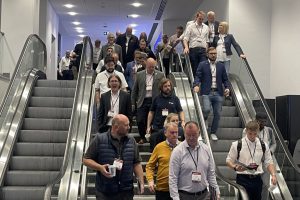ESG takes centre stage
Liza Helps secured a place at the prestigious Industrial Agents Society Conference last month.

PANELLISTS FROM some of the largest development companies in the UK responded to the question – when is the world going to wake up?
Cushman & Wakefield’s head of logistics and industrial EMEA Tim Crighton, Baytree UK development director Amit Babbar, Prologis UK head of Leasing Sally Duggleby, and Tritax Group head of asset management and equity partner Petrina Austin all agreed that occupiers were more familiar with the lexicon of ESG and sustainability than they had been only five years ago.
However, it was acknowledged that with up to 70% of a logistics company’s carbon output hailing from HGVs and LGVs, one of the most visible ways for a company to reduce this would be with a focus on the moving parts rather than the hub itself.
But that could almost be considered a missed opportunity for occupiers. Austin said: “While decarbonisation of the transport network is enshrined, having the best in class buildings in the right locations to support that in the future, is essential.”
Austin also noted that in the drive to decarbonise the transport element, buildings can play a pivotal role supplying supplementary power through roof mounted PV arrays to electric vehicle chargers.
There is a recognition that developers and investors need to future proof their schemes to be able to provide larger amounts of power provision to cope with the direction of travel not just decarbonisation of transport via electrification but also in the ever growing demand for automation and robotics within the warehouse itself.
In an earlier seminar, AI consultant and Data Quotient CEO and founder Nicole Buttner, had already informed the audience that the industrial and logistics sector was positioned to benefit the most from AI through the use of automation of repetitive tasks, the integration of robotics and increased used of AI in warehouse management systems.
Babbar said that integrating warehouse management systems including sensor suites within the building itself was part of a base build from his company. Creating digital twins allowing building functions to be remotely monitored and changes made remotely was of increasing importance to occupiers.
Buttner had mentioned that this layering of AI to drive efficiencies and monitor the effectiveness of warehouse operations was only going to increase and improve productivity.
This theme was carried through to the final seminar of the morning when Institute of Fiscal Studies Director Paul Johnson discussed the economy at large and the need to drive productivity across the board as a way to balance the books and create a resilient UK.
The more intangible issues of ESG were also discussed. Crighton said that it is relatively simple to engage occupiers to reduce operational carbon – a reduction in energy output means an increase in cost savings – but embodied carbon is a bit more difficult to prove.
Despite that there are moves by developers and developer investors to reduce embodied carbon in the built environment, driven by the worldwide movement to decarbonise portfolios to meet financial investment criteria ahead of legislation and international environmental accords such as the Paris Agreement on Climate Change.
Each ESG panellist said that their company was continuously looking at ways to challenge suppliers to improve and reduce embodied carbon.
Duggleby said: “Relatively simple changes in material used or the way construction is carried out or indeed the way vehicles are powered can deliver significant carbon savings.”
Babbar, having cited Baytree’s most recent development at Nuneaton where the offices were built out of cross laminated timber and glulam – which significantly reduced embodied carbon compared to a steel construction equivalent, said: “Obviously, there is a cost to doing this.” However, it was agreed that if the appraisals did not stack up then the developments would simply not be built.
As for the occupiers those looking ahead to that wider environmental legislative piece and taking on board the needs of their customers to be able to identify both direct and indirect carbon output, having a building that is already codified through national and international accreditations such as BREEAM, Global Real Estate Sustainability Benchmark (GRESB), and CRREM certification is critical.






